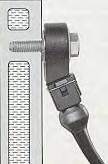 The whole idea of the APC
system is to allow for maximum boost without detonation or knock. Knocking is an explosion
of the air fuel mixture as opposed to a normal controlled burn. When running at high boost
pressures, there is a tendency for violent knocking. In order to push the limit of maximum
boost without damaging the engine, you must protect the engine from this danger. Knocking
combustion causes greater thermal and mechanical stresses on the engine that could damage
it due to pressure fluctuations and increased heat loads. The knocking noise heard is
caused by gas vibrations. (Here is some more info
on Knock and Detonation)
The whole idea of the APC
system is to allow for maximum boost without detonation or knock. Knocking is an explosion
of the air fuel mixture as opposed to a normal controlled burn. When running at high boost
pressures, there is a tendency for violent knocking. In order to push the limit of maximum
boost without damaging the engine, you must protect the engine from this danger. Knocking
combustion causes greater thermal and mechanical stresses on the engine that could damage
it due to pressure fluctuations and increased heat loads. The knocking noise heard is
caused by gas vibrations. (Here is some more info
on Knock and Detonation)
 The knock sensor is an
acceleration sensor that converts vibrations into electrical signals by way of a
piezo-ceramic element. The piezo-ceramic element generates surface charges when mechanical
forces act upon it. You will find the knock sensor mounted to the side of the block
between cylinders 2 and three.
The knock sensor is an
acceleration sensor that converts vibrations into electrical signals by way of a
piezo-ceramic element. The piezo-ceramic element generates surface charges when mechanical
forces act upon it. You will find the knock sensor mounted to the side of the block
between cylinders 2 and three.
Knocking causes vibrations in the engine block that exhibit a
characteristic frequency between 5 and 10 kilohertz (see below). In order to filter out
erroneous noises caused by other mechanical components in the engine the APC system's
brain has the ability to read the signal from the knock sensor, decode it, and make a
knock/no knock decision. If the APC hears knocking it then retards boost in increments of
1.5psi until knock goes away.
 |
 |
| Normal engine running. | Engine Knocking |
Color Key: Filtered Pressure Signal | Signal From Knock Sensor | Cylinder Pressure

Here is a picture of the knock sensors for both the APC and the EZK ignition
system
stacked one on top of the other. The APC sensor in on top.
Proper tightening torque of the knock sensor is:
14 +/- 5 Nm
(10.5 +/- 3.7 lb ft.)